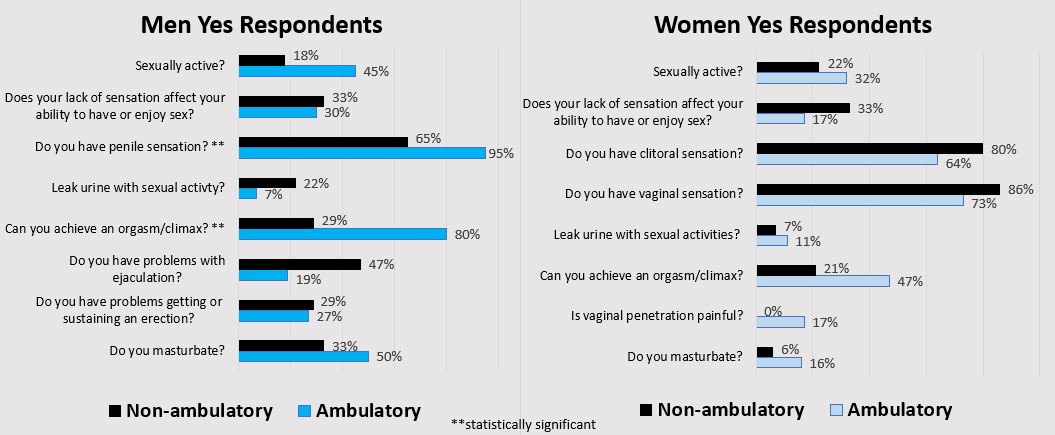Back
Poster, Podium & Video Sessions
Moderated Poster
MP11: Pediatric Urology: Neurogenic Bladder, Reconstruction & Urologic Emergencies
MP11-18: Is Ambulatory Status Associated with Sexual Function and Activity in the Young Adult Spina Bifida Population?
Friday, May 13, 2022
1:00 PM – 2:15 PM
Location: Room 225
Shane Batie*, Janelle Traylor, Shaheer Ali, Samuel Gold, Yvonne Chan, Bruce Schlomer, Micah Jacobs, Dallas, TX

Shane Forest Batie, MD
University of Texas Southwestern Medical Center
Poster Presenter(s)
Introduction: Young adults with spina bifida may suffer altered genital sensation and sexual function. There are no validated questionnaires and few studies examining sexual function and activity in this population. We hypothesized that ambulatory status is associated with sexual function and activity in young adults with spina bifida.
Methods: From 2014-2021, patients in our young adult spina bifida clinic were surveyed using a non-validated sexual questionnaire assessing their genital sensation, sexual function, and sexual activity. Those who could not fill out the questionnaire independently were excluded. Ambulatory status was defined using the 5-point Hoffer classification. Household, community, and normal ambulators were designated as ambulatory. Therapeutic and non-ambulators were categorized as non-ambulatory. Fisher’s exact and chi-square tests were used to compare responses between the two groups.
Results: There were 22 ambulatory (15 lumbar, 2 lumbosacral, 5 sacral) and 22 non-ambulatory (8 thoracic, 14 lumbar) men (median age 20.4 years, range 18.2-26). 95% of ambulatory men reported having some penile sensation compared to 65% of non-ambulatory men (p=0.02). 80% of ambulatory men could achieve orgasm compared to 29% of non-ambulatory men (p=0.04). 42% of ambulatory men were sexually active compared to 18% of non-ambulatory men (p=0.05). 19% of ambulatory men reported problems with ejaculation compared to 47% of non-ambulatory men (p=0.06). There were 19 ambulatory (7 lumbar, 2 lumbosacral,10 sacral) and 17 non-ambulatory (3 thoracic,14 lumbar) women (median age 20.9 years, range 17.8-26.2). We found no significant association between ambulatory status and genital sensation, ability to enjoy sex, sexual activity, or ability to achieve orgasm in women. Masturbation and urinary leakage with sexual activity were not associated with ambulatory status in men or women.
Conclusions: In young men with spina bifida, ambulatory status was associated with positive responses regarding penile sensation, orgasm, ejaculation, and sexual activity. However, ambulatory status was not associated with reporting better sexual function in young women with spina bifida. These results can be used to facilitate discussion about sexual health with young adult spina bifida patients.
Source of Funding: none

Methods: From 2014-2021, patients in our young adult spina bifida clinic were surveyed using a non-validated sexual questionnaire assessing their genital sensation, sexual function, and sexual activity. Those who could not fill out the questionnaire independently were excluded. Ambulatory status was defined using the 5-point Hoffer classification. Household, community, and normal ambulators were designated as ambulatory. Therapeutic and non-ambulators were categorized as non-ambulatory. Fisher’s exact and chi-square tests were used to compare responses between the two groups.
Results: There were 22 ambulatory (15 lumbar, 2 lumbosacral, 5 sacral) and 22 non-ambulatory (8 thoracic, 14 lumbar) men (median age 20.4 years, range 18.2-26). 95% of ambulatory men reported having some penile sensation compared to 65% of non-ambulatory men (p=0.02). 80% of ambulatory men could achieve orgasm compared to 29% of non-ambulatory men (p=0.04). 42% of ambulatory men were sexually active compared to 18% of non-ambulatory men (p=0.05). 19% of ambulatory men reported problems with ejaculation compared to 47% of non-ambulatory men (p=0.06). There were 19 ambulatory (7 lumbar, 2 lumbosacral,10 sacral) and 17 non-ambulatory (3 thoracic,14 lumbar) women (median age 20.9 years, range 17.8-26.2). We found no significant association between ambulatory status and genital sensation, ability to enjoy sex, sexual activity, or ability to achieve orgasm in women. Masturbation and urinary leakage with sexual activity were not associated with ambulatory status in men or women.
Conclusions: In young men with spina bifida, ambulatory status was associated with positive responses regarding penile sensation, orgasm, ejaculation, and sexual activity. However, ambulatory status was not associated with reporting better sexual function in young women with spina bifida. These results can be used to facilitate discussion about sexual health with young adult spina bifida patients.
Source of Funding: none


.jpg)
.jpg)